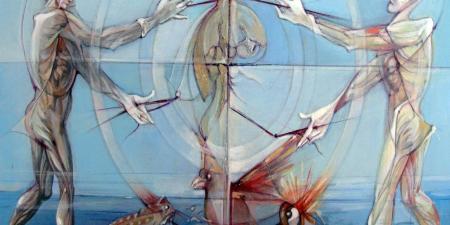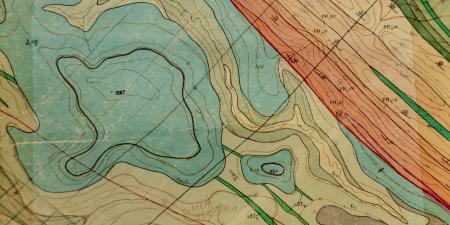Abstract
American Indian (AI) and Indigenous peoples utilize traditional medicine/healing (TM/H) for health and well-being. Allopathic health care practitioners (HCPs) receive minimal training and education on TM/H and its application and integration into health care settings. Lack of knowledge and practice guidelines on how to navigate these 2 health care perspectives (allopathic and traditional) creates uncertainties in the treatment of AI and Indigenous peoples. Such conflicts can undermine patient autonomy and result in culturally incongruent practice. This article presents a case study showcasing suggestions for how HCPs can direct clinical decision making when working with AI/Indigenous patients who utilize TM/H. The article argues that health professions education institutions and HCPs must dedicate effort to expanding awareness of and education about TM/H to enhance the delivery of evidence-based and integrated clinical treatment for AI/Indigenous patients.
Case
Ms Q is a 72-year-old Navajo woman seeing Dr S, a new physician at an Indian Health Service (IHS) unit in New Mexico. Ms Q reports 5 months of weight loss, fatigue, epigastric pain, and jaundice. She lives in a remote community on the Navajo Nation, and her granddaughter drove 2 hours to bring her to the IHS clinic, insisting that Ms Q’s symptoms should be evaluated by an allopathic physician. Traditional Navajo healing practices and customs are important aspects of Ms Q’s life. Although she does not routinely visit the IHS clinic, Ms Q is open to being evaluated by Dr S.
In a follow-up visit, Dr S discusses test results with Ms Q. Based on laboratory evidence of obstructive jaundice and a computed tomography scan revealing a solid mass in the head of Ms Q’s pancreas, Dr S suspects that Ms Q has pancreatic cancer and recommends endoscopic retrograde cholangiopancreatography (ERCP), a procedure that enables examination of the liver and pancreas ducts, with endoscopic ultrasound (EUS) to confirm the diagnosis. Ms Q feels hesitant to pursue ERCP with EUS and the required travel and requests to see her medicine man to discuss her symptoms and Dr S’s recommendations. Unfamiliar with traditional Navajo healing, Dr S wonders how to respond.
Commentary
To provide an adequate response to this clinical case, some knowledge of traditional medicine and healing (TM/H) is required. An in-depth definition of TM/H developed with input from American Indian (AI) traditional medicine healer-practitioners (TH/Ps) follows.1,2 TM/H is broadly defined as the interrelational therapeutic processes involved in the application of sacred, mysterious, and spiritually informed AI/Indigenous cultural knowledge systems and healing practices that are passed down from one generation to the next. TM/H is used to diagnose and treat physical, spiritual, mental, and emotional imbalances that result in illness and distress. The exact practices of TM/H are wide-ranging, vary widely between tribal nations, and include specialized ceremonies that range from short, diagnostic ceremonies to larger, more comprehensive ceremonies that span several days. Sweatlodge ceremonies, all night chant ceremonies, Native American Church ceremonies, purification ceremonies, and the use of herbal remedies are just a few examples of tribe-specific AI/Indigenous ceremonial practices. Characteristics of TM/H include trust between the patient and TH/P, recognition of the sacred nature of TM/H, and incorporation of prayer, ceremony, ritual, or the use of herbal therapies. AI/Indigenous ceremonies, stories, and cultural wisdom are privileged and private information; therefore, details of the interventions may be intentionally restricted for purposes of safeguarding and ensuring the safekeeping and application of the TM/H intervention by a TH/P.
The authenticity of a TH/P is determined by the community that practitioner serves. TH/Ps are vetted by other TH/Ps, family, and the community to which the patient seeking TM/H care belongs. TM/H practice is commonly transferred across generational lineage, with each TH/P receiving years of training by an older relative or mentor prior to independent practice. Attributes of TH/Ps include kindness, respectfulness, humbleness, and self-sacrifice. In addition, TH/Ps are expected to convey love to all living and nonliving entities, are self-disciplined, practice self-care, have a sense of humor, and are spiritual. TH/Ps also possess in-depth cultural teachings, ceremonial knowledge, and tribe-specific wisdom and stories; awareness of sacred orders of time and space; and awareness of or skills in communication between the spiritual and physical worlds. Importantly, they have sacred relationships with self, others, animals, nature, and spiritual realms.1,2
The role of the patient in seeking health and well-being through TM/H involves personal agency, preference, and intent. Based on personal preferences, cultural teachings, level of acculturation, and accessibility to healing and health care modalities, the patient may choose to pursue TM/H as the sole vehicle of care or may take an integrative approach by also seeking Western medicine as a secondary intervention or a concurrent intervention alongside TM/H. It is important to note that patients may not be forthcoming about their use of TM/H when discussing their health with Western health care professionals due to the distrust that some AI/Indigenous peoples have of non-Native interventions or interventions delivered by government agencies.
Practice Challenges
In a discussion of challenges associated with navigating the delivery of allopathic medicine alongside TM/H, it’s important to include challenges perceived or experienced by health care practitioners (HCPs) as well as patients.
Health care practitioner challenges. HCPs rely on scientific evidence as the basis of practice standards. They employ this evidence to support assessment, clinical reasoning, patient autonomy, and treatment recommendations. Contemplating the integration of a complementary or alternative approach, such as TM/H, and evidence-based clinical practice may contribute to HCPs’ practice uncertainty due to the incongruence between science-based knowledge and cultural and spiritual-based knowledge. Another challenge HCPs may experience is respecting patient autonomy by allowing patients to choose and prioritize the health and wellness interventions they feel best fit their physical, mental, emotional, and spiritual needs—especially when patients prefer complementary or alternative approaches. These are valid HCP concerns and must be considered, discussed, and further explored to maintain optimal health and safety of patients.
Safe delivery of TM/H alongside allopathic care requires openness, safe communication, and all practitioners’ understanding of the recommended treatment options. Not all ceremonial interventions are safe for all patients, and the final decision on whether a patient should participate in a physically demanding TM/H ceremony should be reached only after collaborative discussions among all practitioners serving the patient have occurred. For example, a sweatlodge ceremony could be taxing for an acutely ill or frail patient due to the physically demanding aspects of the ceremony. Collaborative and informed approaches allow the patient, TH/Ps, and HCPs an opportunity to discuss safe strategies, which may include a recommendation to proceed, cancel or postpone the ceremony, consider safer approaches, or modify the treatment, thereby reducing associated risks.
The relationship between HCPs and AI/Indigenous peoples is stained with grief, loss, and trauma.
Education and training are critical factors in addressing these concerns. HCPs are likely unaware of TM/H and may have received little or no education or training on practices, safety, and health outcomes related to TM/H. This situation is gradually changing, as some medical and nursing schools have become increasingly informed about safe, culturally congruent, and evidence-based alternative, complementary, and integrative approaches to health care delivery.3,4,5,6,7,8,9,10
Patient challenges. TM/H is critical to the identity and culture of tribal nations and the ways that they relate to the world around them.11,12,13 Two studies from the 1990s indicate that 62% of Navajo had utilized TM/H interventions at some point in their lives,14,15 while 39% received TM/H interventions on a regular basis as a component of their overall health and wellness practices.15 Another study based on an intertribal sample of 30 tribal affiliations found that 38% of patients used TM/H healers and 86% of those who did not use TM/H healers would be open to seeking consultation from a TM/H healer.16 Failure of HCPs to recognize TM/H as a core component of self-identity and wellness for AI/Indigenous patients may be perceived as culturally insensitive, thereby eroding the patient’s autonomy and hindering the development of trust between the HCP and patient. Without the foundation of trust, respect for patient autonomy, and provision of culturally sensitive or congruent care in their relationships with patients, clinicians risk unintentionally harming and disrespecting AI/Indigenous patients. These patients may then begin to distrust, and become unwilling to participate in, allopathic care.17 By contrast, an HCP’s ability to recognize the importance of TM/H to the overall well-being of an AI/Indigenous patient creates opportunities to optimize patient health outcomes through intentional consideration—and sometimes integration—of both healing paradigms.18
Suggestions for Enhancing TM/H Education
TM/H education is necessary and beneficial for HCPs. However, several challenges exist for HCPs who want to learn more about TM/H:
- TM/H is considered sacred knowledge and is sometimes restricted and not shared with individuals outside of the tribal community.
- The diversity of TM/H across tribes creates challenges to learn about the wide array of tribe-specific as well as shared (intertribal) TM/H approaches and specialties.
The lack of training in TM/H is at the core of the dilemma faced by Dr S in this case. Without a solid understanding of TM/H, Dr S does not have the knowledge to accurately evaluate and offer a clinically informed response to Ms Q’s request to seek council with her medicine man. If Dr S were to deny Ms Q’s request and recommend immediate treatment, Dr S might be perceived by the patient and her family as culturally insensitive and disrespecting of patient autonomy. As a result, the patient and her family might be hesitant to engage in an integrated treatment plan or Western health care interventions.
For all HCPs, training in TM/H and in strategies for navigating allopathic medicine and TM/H is imperative to providing comprehensive, culturally inclusive, and effective care to AI/Indigenous patients. TM/H education should be integrated on several levels of allopathic training, including standard medical and nursing training, continuing education, and personal study. Although some courses exist, widely available, robust educational instruction on TM/H may still be far off in development, and personal study may be the most accessible avenue for individual training in TM/H for most HCPs. 3,4,5,6,7,8,9,10
Recommendations for HCPs to expand their understanding of TM/H include engaging in TM/H learning opportunities and advocating for the transformation of health sciences (medicine, nursing, and pharmacy) curriculums through partnerships between academic health centers and tribal communities.3,4,5 These starting points will encourage trust building among all stakeholders and enhance capacity to address the health inequities experienced in AI/Indigenous communities. We recommend navigating each case in a thoughtful manner while tailoring the approach to the needs of all involved in the health of the patient, including the patient. Although it is challenging to propose practice guidelines, we offer the following suggestions for Dr S:
- Extend gratitude to Ms Q for her trust and for her willingness to share—and her openness in sharing—her preference to seek advice from her TM/H practitioner.
- Seek out relevant facts and safety considerations about TM/H practices that are common in Ms Q’s tribal community.
- If Ms Q is willing, respectfully encourage her to share details of the TM/H interventions that she is seeking, which would allow for assessment of safety concerns or contraindications. If she declines to share, an understanding and accepting response is recommended.
- If appropriate, request a collaborative discussion with Ms Q, her family, and the TH/P as a means to co-create and prioritize a safe, comprehensive, culturally sensitive or congruent, integrative, and medically necessary treatment plan. Such meetings should be approached with respect for both Western and traditional health care approaches. A component of this respect includes recognition that some TM/H is sacred and may not be shared.
- If appropriate, invite local cultural experts or TH/Ps to offer regular in-service presentations or consultations on aspects of common TM/H practices. Subjects may include etiquette in discussing TM/H, off-limit topics for discussion, and medically relevant elements of and safety precautions in using TM/H.
- Visit an integrated care delivery site. Such institutes can offer valuable advice and strategies for integrating allopathic and traditional medicine.
This list is in no way exhaustive, but if Dr S were to participate in any of these strategies, he could navigate future encounters involving TM/H from a place of better understanding and respect. Such a change in practice delivery could result in mutually positive interactions, support for patient autonomy, and enhanced trust between himself and the patient.
Integrative Approach
Establishing and maintaining trust is crucial in developing therapeutic relationships with AI/Indigenous patients. The relationship between HCPs and AI/Indigenous peoples is stained with the grief and the losses that occurred in historical traumatic events. This history presents a major hurdle for allopathic HCPs to overcome in building trust with AI/Indigenous patients. Building trust is more challenging when HCPs are unfamiliar with the cultural and traditional practices of their patients, highlighting the need for an informed integrative approach. Creating times and spaces to discuss integration of TM/H and allopathic medicine must be prioritized and realized.
Themes intended to guide HCPs, TH/Ps, and national organizations as they embark on the safe integration of TM/H within Western health care settings were generated from discussion among TH/Ps and HCPs in 2010 and at the Traditional Medicine Summit of 2019.1,2 The themes identified include perception (spirituality), translation (humility), protection (sustainability), and contribution (accountability).2 These themes (drawn directly from discussions led by TH/Ps) align directly with discussion points in this article on the sacredness of TM/H, the integral and cultural importance of TM/H to Indigenous peoples, the importance of increasing TM/H education and training for HCPs and agencies that serve Indigenous populations, and developing safe integrative practices across health care settings, education, and research.
Across the globe, we are seeing much-needed changes to health care delivery that are inclusive of AI/Indigenous TM/H approaches. The state of Arizona has a model of reimbursement for the delivery of culturally congruent, safe, and evidence-based health care services for American Indians.19 Further evidence of change is the Traditional Medicine Summit of 2019, which was hosted by national health care delivery organizations (the National Institutes of Health, the Centers for Disease Control and Prevention, and the Center for Complementary and Integrative Health) and which demonstrated national and global support for tailored, integrated, and culturally congruent health care delivery approaches for our diverse nation—specifically, AI/Indigenous populations.2,20
Conclusion
Lack of familiarity with TM/H and lack of practice guidelines for clinical decisions involving safe integration of TM/H are just 2 of the obstacles faced by HCPs and Indigenous patients as they collaborate in allopathic health care services. Although it is unreasonable to request that HCPs gain a comprehensive understanding of TM/H, there are certainly areas in which basic TM/H education is possible. In addition, HCPs who demonstrate understanding of TM/H and respect for patient autonomy by supporting patients if and when they express a preference either for TM/H or an integrated approach to achieve health and wellness can strengthen the patient-practitioner relationship. Cultivating knowledge of TM/H, recognizing TM/H as an integral component of some Indigenous people’s identity, and creating space to integrate allopathic care and TM/H can lead to significantly better care. The case study presents the complexities involved in the clinical decision-making process, and we hope it sheds light on the breadth of awareness and further education required to effectively navigate practice dilemmas of this type, which are often encountered by HCPs serving AI/Indigenous patients.
References
- Moorehead VD Jr, Gone JP, December D. A gathering of Native American healers: exploring the interface of Indigenous tradition and professional practice. Am J Community Psychol. 2015;56(3-4):383-394.
-
Tribal Health Research Office, National Institutes of Health. NIH 2019 Traditional Medicine Summit: Maintaining and Protecting Culture Through Healing; Wednesday, November 20, 2019-Friday, November 22, 2019; Aurora, CO. https://dpcpsi.nih.gov/thro/tms. Accessed May 8, 2020.
- Kamaka ML. Designing a cultural competency curriculum: asking the stakeholders. Hawaii Med J. 2010;69(6)(suppl 3):31-34.
-
Mews C, Schuster S, Vajda C, et al. Cultural competence and global health: perspectives for medical education—position paper of the GMA Committee on Cultural Competence and Global Health. GMS J Med Educ. 2018;35(3):Doc28.
- Sundberg MA, Charge DPL, Owen MJ, Subrahmanian KN, Tobey ML, Warne DK. Developing graduate medical education partnerships in American Indian/Alaska Native Communities. J Grad Med Educ. 2019;11(6):624-628.
-
American Association of Colleges of Nursing. Cultural competency in nursing education. https://www.aacnnursing.org/Education-Resources/Tool-Kits/Cultural-Competency-in-Nursing-Education. Accessed June 17, 2020.
-
Sherrill WW, Mayo RM, Truong KD, Pribonic AP, Schalkoff CA. Assessing medical student cultural competence: what really matters. Int J Med Educ. 2016;7:248-254.
- McElfish PA, Moore R, Buron B, et al. Integrating interprofessional education and cultural competency training to address health disparities. Teach Learn Med. 2018;30(2):213-222.
- Engebretson J, Mahoney J, Carlson ED. Cultural competence in the era of evidence-based practice. J Prof Nurs. 2008;24(3):172-178.
- Kesler DO, Hopkins LO, Torres E, Prasad A. Assimilating traditional healing into preventive medicine residency curriculum. Am J Prev Med. 2015;49(5)(suppl 3):S263-S269.
- Hartmann WE, Gone JP. Incorporating traditional healing into an urban American Indian health organization: a case study of community member perspectives. J Couns Psychol. 2012;59(4):542-554.
- Iron Cloud S, Bucko RA. Contemporary practices in Lakota healthcare. South Med J. 2008;101(6):599-600.
-
Marsh TN, Coholic D, Cote-Meek S, Najavits LM. Blending Aboriginal and Western healing methods to treat intergenerational trauma with substance use disorder in Aboriginal peoples who live in northeastern Ontario, Canada. Harm Reduct J. 2015;12:14.
-
Garro LC. Consultations with Anishinaabe (Ojibway) healers in a Manitoba community. Arctic Med Res. 1991;suppl:213-216.
- Kim C, Kwok YS. Navajo use of Native healers. Arch Intern Med. 1998;158(20):2245-2249.
- Marbella AM, Harris MC, Diehr S, Ignace G, Ignace G. Use of Native American healers among Native American patients in an urban Native American health center. Arch Fam Med. 1998;7(2):182-185.
- Moghaddam JF, Momper SL, Fong TW. Crystalizing the role of traditional healing in an urban Native American health center. Community Ment Health J. 2015;51(3):305-314.
-
Harding MC, Bott QD. Earning trust among Native American populations. Acad Med. 2019;94(4):460.
-
Arizona Health Care Cost Containment System. Proposed AZ 1115 waiver language: AHCCCS reimbursement for traditional healing services. https://www.azahcccs.gov/AmericanIndians/Downloads/Consultations/Meetings/2016/TraditionalHealingWaiverLanguage.pdf. Published 2016. Accessed June 17, 2020.
-
Tribal Health Research Office, National Institutes of Health. 2019 Traditional Medicine Summit; November 20, 2019 to November 22, 2019; University of Colorado Anschutz, Aurora, CO. https://dpcpsi.nih.gov/sites/default/files/dpcpsi/document/TMS%20save%20the%20date.pdf. Accessed July 10, 2020.



